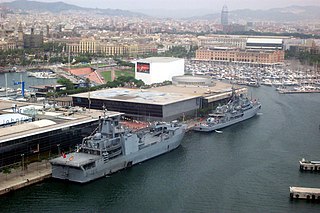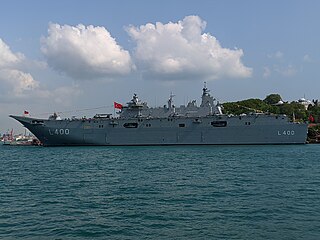
The Turkish Naval Forces, or Turkish Navy, is the naval warfare service branch of the Turkish Armed Forces.

Juan Carlos I is a multi-purpose amphibious assault ship-aircraft carrier in the Spanish Navy. Similar in role to many aircraft carriers, the amphibious landing ship has a ski jump for STOVL operations, and is equipped with the McDonnell Douglas AV-8B Harrier II attack aircraft or the new Lockheed Martin F-35B Lightning II fighter aircraft. The vessel is named in honour of Juan Carlos I, the former King of Spain.

MILGEM project is a national warship program of the Republic of Turkey. Managed by the Turkish Navy, the project aims at developing multipurpose corvettes, frigates and destroyers that can be deployed in a range of missions, including reconnaissance, surveillance, early warning, anti-submarine warfare, surface-to-surface and surface-to-air warfare, and amphibious operations.

The TF-2000-class destroyer is a projected anti-air warfare guided-missile destroyer currently undergoing development by the Turkish Naval Institute. The class will provide survivability in the presence of aerial threat and also support mission functions such as command, control, and communications, reconnaissance, early warning, surface warfare, anti-submarine warfare and electronic warfare. Moreover, once in service, the TF-2000s are slated to be an integral part of Türkiye's expeditionary strike groups centered around the TCG Anadolu LHD and the country's future aircraft carrier(s). The TCG Anadolu is to be followed up by the TCG Trakya light aircraft carrier and President Erdoğan has also hinted at the construction of a larger aircraft carrier that is to be designed in cooperation with Spain. These capital vessels require destroyer escorts to defend them against enemy aircraft, ships and submarines; in other words, the perfect role for the TF-2000s once these new designs are slated for operational service by 2038. On 5 December 2007, Defence Industry Executive Committee approved plans to build six ships of this class. In January 2013, it was announced that Turkey was planning to acquire a total of 8 TF-2000 destroyers, which was confirmed at the International Defence Industry Fair (IDEF) 2021. With the realization of the project, it is intended to improve the anti-air warfare (AAW) capabilities of the Turkish Navy.

The Barbaros-class frigates are among the most modern frigates in the Turkish Navy. They were designed in Germany and are part of the MEKO group of modular warships, in this case the MEKO 200 design. Two ships were built in Germany and two in Turkey with German assistance. They are larger than the previous Yavuz-class frigates and are also faster due to using CODOG machinery rather than pure diesels.
Foça Naval Base is a base of the Turkish Navy on the eastern coast of Aegean Sea, 4.2 km (2.6 mi) south by south-east of Foça in İzmir Province. The base is home to the Marines for amphibious operations.

TCG Osmangazi (NL-125) is an amphibious warfare ship of type landing craft tank that was built for the Turkish Navy in the early 1990s. The ship remains in service.

TCG Heybeliada is the lead ship of the Ada-class ASW corvettes of the Turkish Navy. Heybeliada was named after Heybeliada Island, where the Turkish Naval High School is located. Heybeliada Island is part of the Prince Islands archipelago in the Sea of Marmara, to the southeast of Istanbul.

SMART-S Mk2(Signaal Multibeam Acquisition Radar for Tracking, S band Mk2) is a naval medium to long-range air and surface surveillance multibeam passive electronically scanned array 3D radar designed by Thales Nederland, formerly Hollandse Signaalapparaten (Signaal). While the original SMART-S radar was only produced in small numbers, SMART-S Mk2 is very successful. Only six years after its introduction, 30 systems were sold to navies all over the world. SMART-S Mk2 radar is equipped with transmitter/receiver (T/R) modules manufactured by Turkish defence company Aselsan. The radar transmitter/receiver (T/R) modules for the radar are purchased by Thales from Aselsan.

The Ada class is a class of anti-submarine corvettes developed primarily for the Turkish Navy during the first stage of the MILGEM project. The Turkish Navy has commissioned all four Ada-class corvettes.

TCG Anadolu (L-400) is an aircraft carrier of the Turkish Navy. It is named after the peninsula of Anatolia which forms the majority of the land mass of Turkey. The construction works began on 30 April 2016 at the shipyard of Sedef Shipbuilding Inc. in Istanbul, with the keel being laid on 7 February 2018. TCG Anadolu was commissioned with a ceremony on 10 April 2023.

The Akar class is a series of two replenishment oilers and fleet support ships, designed and built for service in the Turkish Navy. The lead ship of the class, TCG Akar, was constructed in 1982–1983 and entered service in 1987. The second ship, TCG Yarbay Kudret Güngör, was constructed in 1993–1994 and entered service in 1995. Both ships were constructed in Turkey, though Yarbay Kudret Güngör was the first ship built for the Turkish Navy by a private shipyard. Both vessels remain in service.

TCG Oruçreis, is a Barbaros-class frigate of the Turkish Navy, the second ship of that class. She was named for Oruç Reis, the Ottoman Beylerbeyi of the West Mediterranean. The submarine TCG Oruç Reis was the first ship of that name in the Turkish Navy.
TCG Kınalıada (F-514) is the fourth ship of the Ada-class ASW corvettes of the Turkish Navy. Kınalıada was named after Kınalıada Island, a part of the Princes' Islands archipelago in the Sea of Marmara, to the southeast of Istanbul, Turkey.
The Reis-class submarines are a group of six license built submarines based on the Type 214 submarine for the Turkish Navy.

Sedef Shipyard is a Turkish shipyard established in Gebze, Kocaeli in 1972. Shipyard moved to Tuzla, Istanbul in 1990. The shipyard is building defense industry ships and commercial ships such as the multi-purpose amphibious assault ship TCG Anadolu to be used by the Turkish Naval Forces. In 2000, the shipyard became a subsidiary of Turkon Holding.
Anadolu Shipyard (ADİK) is a Turkish shipyard located in Tuzla, Istanbul. The shipyard mostly builds amphibious warfare ships as part of the defense industry.

The Baykar Bayraktar TB3 is a Turkish medium-altitude long-endurance (MALE) unmanned combat aerial vehicle (UCAV) capable of short-range landing and take-off, produced by Baykar. It is currently being developed due to the lack of aircraft to be deployed on the TCG Anadolu amphibious assault ship. According to the initial plans the ship was expected to be equipped with Lockheed Martin F-35B Lightning II fighter jets but following the removal of Turkey from the procurement program, the vessel entered a modification process to allow it to be able to accommodate UAVs.














